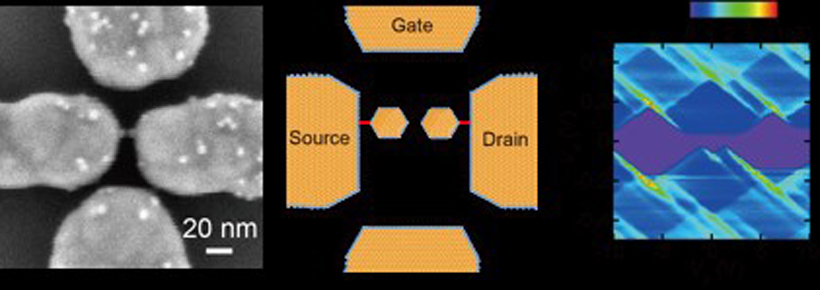A detailed analysis of the electrical characteristics of a tiny transistor made from two quantum dots could help researchers design better devices to manipulate single electrons
From the Journal: Journal of Applied Physics
WASHINGTON, D.C., October 6, 2015 — A single-electron transistor (SET) is an electrical device that takes advantage of a strange quantum phenomenon called tunneling to transport single electrons across a thin insulator. The device serves as an on/off switch on the tiniest scale and could play an important role in quantum computing.
A group of researchers in Japan is exploring the behavior of a certain type of SET made from two quantum dots, which are bits of material so small they start to exhibit quantum properties. The group has produced a detailed analysis of the electrical characteristics of the so-called double-quantum-dot SETs, which could help researchers design better devices to manipulate single electrons. They report their findings in the Journal of Applied Physics, from AIP Publishing.
The team began their work by fabricating the electrodes of the SET, which were separated by a nanometer scale gap, with an electroless gold-plating technique. They then synthesized size-controlled gold nanoparticles within the gap.
To do this, they “chemically assembled a series of double-dot SETs by anchoring two gold nanoparticles between the nanogap electrodes with alkanedithiol molecules to form a self-assembled monolayer,” explained Yutaka Majima, a professor in the Materials and Structures Laboratory at the Tokyo Institute of Technology.
The team tested the electrical properties of the device and found that regions within the quantum dots exhibited zero conductance and a stable electron number — both highly desirable traits for quantum computing. Such regions are called Coulomb diamonds and their properties are “extraordinarily stable and coveted,” Majima said.
The same researchers had earlier found Coulomb diamonds in single-quantum-dot SETs.
The group — which also includes members from Kyoto University, the University of Tsukuba, and Japan Science and Technology Agency (JST) — was then able to determine, through both theoretical and experimental analysis, many additional important electrical parameters of the SETs. The team then linked these parameters to the geometry of the device.

“Thanks to [the Coloumb diamond] stability, we could determine the equivalent circuit parameters with accuracy by analyzing the device’s electrical characteristics,” said Majima. “Precise estimation of the circuit parameters results in the determination of double-dot structures, which can be critical for reproducible single-electron devices.”
Majima and colleagues found that the evaluated parameters “corresponded well to the geometrical structures of the device,” which they were able to observe via scanning electron microscopy.
In terms of applications, it’s quite possible that the team’s work with double-dot SETs will find future use within quantum electronics to manipulate a single electron and its spin.
The researchers’ next goal is “to manipulate and control a single electron and its spin on double-dot single-electron devices by using asymmetric side-gate electrodes to demonstrate spin qubits,” said Majima.
Qubits, aka quantum bits, can encode both a “zero” and a “one” at the same time within their relative spin, so they are being pursued for storing and manipulating information in quantum computers.
###
For More Information:
Jason Socrates Bardi
jbardi@aip.org
240-535-4954
@jasonbardi
Article Title
Authors
Shinya Kano, Kosuke Maeda, Daisuke Tanaka, Masanori Sakamoto, Toshiharu Teranishi and Yuraka Majima
Author Affiliations
Tokyo Institute of Technology, Kyoto University, University of Tsukuba, Japan Science and Technology Agency (JST)
